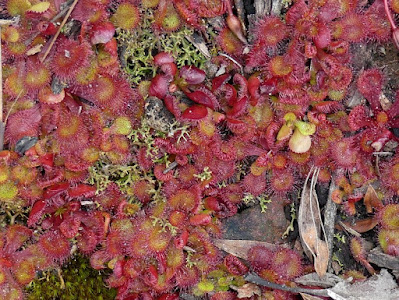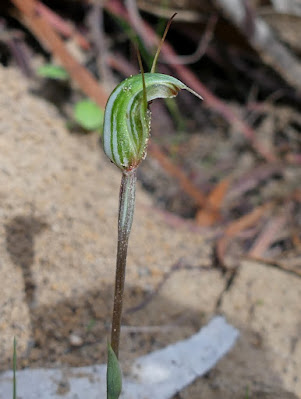[See notice at end re resumption of posts]
In my most recent post, I introduced the wonderful Gariwerd (or Grampians) National Park in western Victoria, one of our favourites. There wasn't room in one post to do it justice, so I left most of the flower photos to this second instalment. Accordingly this is simply a celebration of some of the wildflowers we enjoyed there in a couple of spring visits - one in the dry September of 2019, just before La Niña began to drench Australia and COVID changed everything, and the other only a few weeks ago in the very wet October of 2022. It's really just an annotated photo gallery. For the most part you'll be able to tell which photos were from which trip - the most recent ones tend to be in very dull light and often with raindrops still on the flowers!
In the last post I introduced some plants that are endemic to Gariwerd, but many of those that follow are quite widespread. However the ranges are particularly rich in spring flowers and worth celebrating for that, so quite of lot of flowers follow! There are also some species here that are only found in western Victoria. There's no particular rationale for the order in which the photos appear, though I have kept members of the same plant families together. Let's start with some wattles, and why not?
 |
Spike Wattle Acacia oxycedrus growing among the rocks near Boroka Lookout,
above and below.
|
 |
The wicked thorns and flowers in (much more benign) spikes make this wattle
very distinctive. It grows in heathy dry forest along the coast and hinterlands
of south-eastern Australia.
|
 |
Myrtle Wattle A. myrtifolia grows in near-coastal areas (at its closest point Gariwerd is
only 85k from the sea) from south-western Australia all the way to south-east Queensland.
|
 |
Golden Wattle A. pycnantha which, as I'm sure you're aware (if you're Australian at least),
is our national floral emblem. It does occur in six of the eight states and territories,
being only absent from Queensland and the Northern Territory.
|
 |
Wirilda Acacia retinodes, which can produce the very pale flowers at almost any
time of year (here in September) but peaks in summer. The long slender single-veined
phyllodes have a distinctive bluish tinge.
|
The heaths are prominent (as they are in the understorey of many south-eastern drier forests and coastal heathlands). I've just used 'heath' in two different senses in that sentence. The Australian plants related to the northern hemisphere family Ericaceae were long put into their own family Epacridaceae, but as is the wont of modern botanical taxonomy it has been subsumed into a huge and somewhat amorphous enlarged Ericaceae. (I've quietly lamented the loss of nuance in this trend, and won't do so again here.) The other use of 'heath' is as a habitat descriptor, referring to an understorey or near-treeless expanse of hard-leaved shrubs growing in low-nutrient wet or dry sandy soils. (Members of the heath family are often prominent in such habitats.)
Here are three heath species which are commonly found in Gariwerd, the first of which is the Victorian floral emblem (though it also grows in South Australia, south-eastern NSW and throughout Tasmania).
 |
Common Heath Epacris impressa (above and below) ranges in colour from
deep red to pale pink to white. Here are a couple of variants. It is very (and
pleasingly) common throughout Gariwerd and well beyond.
|
 |
Pine Heath Astroloma pinifolium really does have very pine-like foliage, as well as
unusual green-tipped yellow flowers.
|
 |
Golden Heath Styphelia adscendens is another striking heath species, with long
stamens and furry rolled-back petals. Like many other species featured here
it is also found well beyond the ranges of Gariwerd.
|
Members of the Proteaceae family are prominent here, as pretty much everywhere in Australia. Last time we met the lovely Flame Grevillea, which is restricted to Gariwerd, and the Rock Banksia, which is found only here and on Mornington Peninsula. Here are a couple of other family members.
 |
Mountain Grevillea G. alpina, a very attractive, widespread and variable species found in drier
forests of Victoria and south-eastern NSW (including the ACT). At times it's been suggested
that more than one species is involved, which seems intuitively plausible,
but it seems the genetics doesn't support the idea.
|
 |
Holly Grevillea G. aquifolium, a striking species found mostly in western Victoria, and
to a lesser extent in south-eastern South Australia.
|
 |
Beaked Hakea (or Turkey-gobbler) H. rostrata (all three names come from the
distinctively shaped large woody fruit). Found from central Victoria
to well into South Australia.
|
 |
Victorian Smokebush Conospermum mitchellii. Of 52 named species of smokebush,
only eight are found outside of WA; this one is limited to western Victoria, especially
Gariwerd. Many of the WA species have blue-grey flowers which, en masse, look
like smoke haze from a distance, but this one is gleaming white.
|
Pea plants are of course everywhere, and last time I featured the Gariwerd endemic Grampians Parrot-Pea. Here are three other, more widespread peas of Gariwerd.
 |
Showy Parrot-Pea Dillwynia sericea, found from Kangaroo Island to the far
north of NSW. I don't get bored with it though...
|
 |
Rough Bush-Pea Pultenea scabra, a familiar pea on the south-eastern mainland,
with very distinctive leaves.
|
From here until the last bundle of offerings, each family is represented by just one species.
 |
Rough Star-hair Astrotricha ledifolia (Family Araliaceae), a widespread family which
includes ivy and ginseng. A very distinctive shrub with hairy flower stems, found in
scattered locations across Victoria.
|
 |
Pale Grass-Lily Caesia parviflora, a widespread and attractive little lily.
|
 |
By contrast with some previous widespread species, this glorious Blue Tinsel-Lily
Calectasia intermedia is found only from Gariwerd west to the SA border, and in adjacent
areas of that state. Moroever it is the only Calectasia - and indeed the only member of the family
Dasypogonaceae - found outside of Western Australia.
|
 |
Snow Myrtle Calytrix alpestris, another lovely plant, especially in flower, has a
similar (though slightly wider) distribution to the Calectasia, in heathlands of
western Victoria and adjacent South Australia.
|
 |
Bundled Guinea Flower Hibbertia fasciculata is probably the most conspicuous
of the several species of guinea flower in Gariwerd, with dense furry cylindrical
leaves up the often erect stem. Family Dillenaceae.
|
 |
Wedge-leaf Hop Bush Dodonea cuneata has very inconspicuous little
green flowers but beautiful big glossy red winged fruits.
|
 |
Large-leaf Ray Flower Cyphanthera anthocercidea is a rare and Endangered species, found
only in Gariwerd and nearby Mount Arapiles, and on the other side of the state in a few
localities in Gippsland. It is in the Solanaceae family, with tomatoes, potatoes and tobacco,
plus quite a few Australian species.
|
 |
Love Creeper Comesperma volubile, a very pretty climber in the family Polygalaceae.
Unlike the previous species this one has a huge range across near-coastal southern
Australia from Brisbane to Tasmania to north of Perth.
|
 |
Shrubby Velvet Bush Lasiopetalum macrophyllum Family Malvaceae (though until fairly
recently it was in the much smaller family Sterculiaceae, and who knows what is yet to
come?). In Victoria it is found mostly in the far east, except for a few populations
in Gariwerd - including this one at Golton Gorge.
|
 |
Bendigo or Fairy Waxflower Philotheca (formerly Eriostemon) verrucosa, another beautiful
snowy white flower. Found in Victoria mostly in Gariwerd and the central Goldfields, and
in Tasmania, plus outliers in the Mount Lofty Ranges. Family Rutaceae (like citruses and boronias).
|
 |
Round-leaf Mintbush Prostanthera rotundifolia, a profusely flowering beauty
found in rocky areas throughout south-eastern Australia.
|
 |
Dusty Miller Spyridium parvifolium at Boroka Lookout.
The 'dusty' pale leaves surrounding the inconspicuous flowers draw attention
to them. I like to think this gives us an indication of how petals originally developed.
|
 |
Pink Bells Tetratheca ciliata, found everywhere in Gariwerd and a constant source of pleasure.
Its flowers are bigger than those of other Tetratheca I know. Tetratheca's family Tremandraceae
has been subsumed into the bigger and ancient Gondwanan family Eleocarpaceae, following
a common pattern in botanical taxonomy in recent times.
|
 |
Fairy's Apron Utricularia dichotoma. These tiny flowers grow in wet areas (this one
was part of a colony growing in thick moss on a rock sheet). They prey on very small
organisms in the water beneath them, by means of little 'bladders' which 'suck' in water
and tiny organisms.
|
 |
Grass Tree Xanthorrhoea australis; this is a familiar sight in many places (though I never
tire of them) but I was intrigued by the oddly chopped-off flower spike, present on
several of these plants in the area near Mount Zero in the north.
|
And finally, those who know me will not be at all surprised that I'm going to end this Gariwerd floral odyssey with a selection of the orchids we saw. Some are common and widespread, others not nearly so much, but I enjoy them all every time; I hope you do too!
 |
Gnat Orchid Cyrtostylis reniformis, yet another species widespread in the south-east but,
despite growing in colonies, it's not always easy to see in the shady situations where it often grows.
|
 |
Rabbit Ears Thelymitra antennifera; the odd name refers to the red-brown erect lobes
on the column in the middle of the flower. It's one of the sun orchids, but is a bit more
willing to open on cloudy days than many others in the group.
A widespread orchid across southern Australia, but not as far north as NSW.
|
 |
Pygmy Caladenia, or Tiny Fingers, Caladenia pusilla, a very small finger orchid indeed;
it is found scattered across south-eastern Australia, but is rarely apparently common.
However its diminutive size and similarity to other, much commoner, caladenias
probably confuses the situation. We only found this one, up near Mount Zero.
|
 |
And to finish, a beautiful spider orchid which is giving me considerable angst
regarding its identity. I enquired on a very knowledgeable orchid facebook
group, where I was assured by a couple of authorities that it is the Critically
Endangered Dainty Spider Orchid Caladenia ampla. I'd have no argument with that,
and it certainly looks like it, but the Flora of Victoria tells me that while it
grows nearby it doesn't actually live in Gariwerd itself. If anyone reading this
can advise me of what I'm missing here I'd be very grateful indeed!
|
And that might just about do us on some of the fabulous flowers of this fabulous park; it's turned out to be a longer post than even I'd anticipated! If you've gone the full journey with me I'm very grateful, and I hope you've enjoyed it as much as I have. And it's worth bearing in mind that while spring is clearly peak wildflower season there, any time of year it's a great destination, including for flowers. Please do drop by when you can, you won't regret it.
I'M TAKING A SHORT BREAK FROM BLOGGING UNTIL JANUARY.
I'LL NOTIFY YOU, AS USUAL, WHEN THE NEXT ONE GOES UP;
SEE BELOW IF YOU'RE NOT ON MY NOTIFICATIONS LIST AND WOULD LIKE TO BE.
I
love to receive your comments and in future will be notifying you
personally by email when a new posting appears, if you'd like me to. All
current subscribers have been added to this mailing list and have
already been contacted. This will mean one email every three weeks at the current rate of posting. I promise never to use the list for any other purpose and will never share it.
Should you wish to be added to it, just send me an email at calochilus51@internode.on.net. You can ask to be removed from the list at any time,or could simply mark an email as Spam, so you won't see future ones.





















































